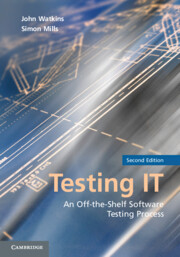Book contents
- Frontmatter
- Contents
- Foreword to the Second Edition by Geoff Thompson
- Foreword to the First Edition by Maurice Rosenburgh
- Acknowledgments
- 1 Introduction
- PART 1 THE TRADITIONAL TESTING PROCESS
- PART 2 THE TESTING PROCESS IN THE REAL WORLD: ILLUSTRATIVE CASE STUDIES
- PART 3 THE APPENDICES
- Appendix A Terms of Reference for Testing Staff
- Appendix B Testing Guides
- Appendix C Test Plan Document Template
- Appendix D Test Specification Document Template
- Appendix E Test Script Template
- Appendix F Test Result Record Form Template
- Appendix G Test Log Template
- Appendix H Test Certificate Template
- Appendix I Reuse Pack Checklist
- Appendix J Test Summary Report Template
- Appendix K Equivalence Partition Example
- Appendix L Boundary Value Analysis Example
- Appendix M State Transition Example
- Appendix N Pairwise Testing Example
- Appendix O Automated Testing Tool Selection Criteria
- Appendix P Usability Testing Overview
- Appendix Q Testing Process Health Check
- Appendix R The Testing of Object-Oriented Software
- Appendix S Pragmatic Test Process Adoption – a Real-World Example
- References
- Glossary
- Index
Appendix E - Test Script Template
Published online by Cambridge University Press: 03 May 2011
- Frontmatter
- Contents
- Foreword to the Second Edition by Geoff Thompson
- Foreword to the First Edition by Maurice Rosenburgh
- Acknowledgments
- 1 Introduction
- PART 1 THE TRADITIONAL TESTING PROCESS
- PART 2 THE TESTING PROCESS IN THE REAL WORLD: ILLUSTRATIVE CASE STUDIES
- PART 3 THE APPENDICES
- Appendix A Terms of Reference for Testing Staff
- Appendix B Testing Guides
- Appendix C Test Plan Document Template
- Appendix D Test Specification Document Template
- Appendix E Test Script Template
- Appendix F Test Result Record Form Template
- Appendix G Test Log Template
- Appendix H Test Certificate Template
- Appendix I Reuse Pack Checklist
- Appendix J Test Summary Report Template
- Appendix K Equivalence Partition Example
- Appendix L Boundary Value Analysis Example
- Appendix M State Transition Example
- Appendix N Pairwise Testing Example
- Appendix O Automated Testing Tool Selection Criteria
- Appendix P Usability Testing Overview
- Appendix Q Testing Process Health Check
- Appendix R The Testing of Object-Oriented Software
- Appendix S Pragmatic Test Process Adoption – a Real-World Example
- References
- Glossary
- Index
Summary
Introduction
This appendix contains a test script template that may be copied and used to record the information necessary for conducting each test comprising a particular testing phase. An electronic version of the template can be obtained using the following link: http://www.cambridge.org/9780521148016/.
A completed example of a test script (Figure E1) is also included at the end of this appendix for guidance.
For each test, a separate test script will need to be completed by the test analyst. Each test script contains the following sections:
Project ID – the unique project identifier
AUT title – the definitive title of the application under test (front sheet only)
AUT version – the definitive version information for the AUT (front sheet only)
Testing phase – the title of the phase of testing being conducted (e.g., unit test, integration test, system test, etc.) (front sheet only)
Date of test – the planned start date of testing (front sheet only)
Test ID – the unique identifier for the test
Purpose of test – a brief description of the purpose of the test including a reference where appropriate to the requirement that is to be tested (consider providing references to the requirements specification, design specification, user guide, operations guide, and/or installation guide), as well as any dependencies from or to other test scripts/test cases
[…]
Information
- Type
- Chapter
- Information
- Testing ITAn Off-the-Shelf Software Testing Process, pp. 243 - 247Publisher: Cambridge University PressPrint publication year: 2010
